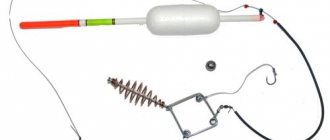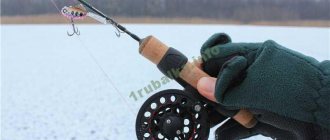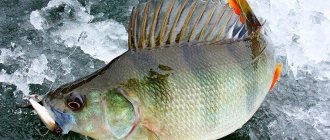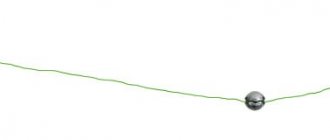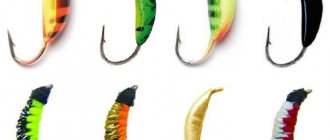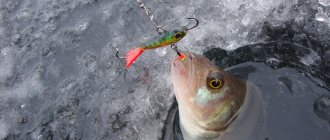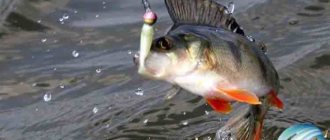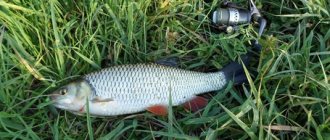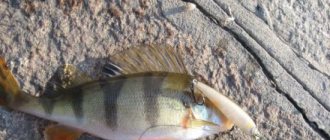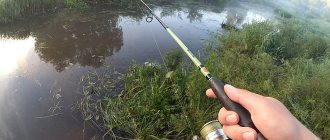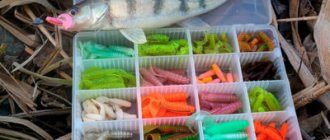As everyone knows, perch is a fish that leads a predominantly schooling lifestyle. The principle of forming flocks is very simple and primitive. Larger individuals usually live in groups of four or even six individuals. Smaller representatives of this species form flocks several times larger and attack smaller prey than groups of large predators. Surely, when you are near a pond, you have noticed that a fish is jumping out of the water, escaping from its pursuers. Summer fishing for perch using a spinning rod is very exciting and exciting, but its success depends on many subtleties.
Where to look for perch in summer
In ponds and small lakes, perch is found everywhere in summer. On rivers and large lakes, you should pay attention to the following signs of the presence of a predator:
• Bottom depressions and depth differences, over which there is a calm or counter current. A countercurrent usually forms behind artificial barriers and islands of reeds protruding above the surface of the water;
• River bays;
• Trees that have fallen into the water and existing driftwood at the bottom;
• Accumulation of schools of small fish;
• Steep banks. Perch is found in different water levels. It depends on the temperature. Large predators descend below the scurrying schools of small perch.
In intense, persistent heat, large individuals enter bottom depressions, coastal reed thickets and shaded cliffs or dumps. Already from the beginning of August, the activity of the predator increases, and it can peck in different horizons of the reservoir.
How the float tackle works
To catch perch on a float in August or October, a fly rod is used, as well as a match rod with which you can cast over a distance of up to 20 meters. The difference between these two gears is the presence or absence of a reel. In the first case, with a fly fishing rod (up to 7 meters long), a reel is not used, but the equipment includes a special drum for storing the thread during transportation.
Tips for fisherman: Reelless for perch in winter are the most catchy - How to best use
The match rod is equipped with an inertia-free rod, which makes it possible to cast long-distance bait over tens of meters. Most reels are equipped with a friction clutch that is activated when a large predator bites.
Next, we will describe how to make a rig for perch with your own hands:
Photo 2. Large float for a large trophy.
«>
Summer fishing for perch with a float rod
When fishing from a boat or shore, perch fishing in the summer is often done with a float rod. Any type of float rod is suitable for catching a striped predator. The Bolognese fishing rod meets all the requirements. The tackle is characterized by high mobility. Even when fishing with several tackles, quickly laying down the fishing rods allows you to quickly pack up and move to another place.
To catch large perch, you need to adjust the equipment for fishing with live bait. It is enough to attach a tee to a leash 20-50 cm long. All that remains is to place the live bait correctly so that with its mobility it attracts the attention of the predator for as long as possible.
What to use to catch perch (striped robber) in the summer?
As a rule, experienced fishermen consider spinners to be their priority tackle.
Catching summer perch with a spinning rod
The most important thing in catching perch with a spinning rod is the correct selection of the rod. It must have a test of at least 15-20 grams and a medium or medium-fast action.
The spinning rod is equipped with a spinning reel with a spool size of 2000. It is mandatory to use braid with a diameter of 0.16 to 0.2 mm. When using thicker fishing line, you can greatly lose the sensitivity of the bite, which will negatively affect the fishing performance.
The most popular baits are wobblers, spinners and tail spinners.
Spinner is the easiest option for catching perch. It is best to use oscillating spoons, as they best imitate the movements of small fish.
Wobblers - a hard bait that imitates the color and shape of a small fish - are most often used in a spotted color with two hooks.
However, the tail spinner is considered the most catchy tackle. Thanks to its fast movements in the water, it perfectly attracts the attention of perch.
Tips for fisherman: Fishing for grayling on small rivers in summer video - Features of choice
Fishing for perch in summer on a float
Catching perch with float tackle also has the right to life.
When using a long enough rod, it becomes possible to feed the bait straight into the vegetation - this is where the perch likes to hide.
A fishing line with a diameter of 0.25-0.28 mm, a rounded float, sinkers and a hook of a suitable size - that’s all that is required to catch perch with a fishing rod.
What do you bite perch on in the summer?
The universal bait for catching the “striped robber” was and remains an ordinary earthworm (or better yet, a dung worm). Fishermen use both grasshopper and dragonfly larva as bait.
Large perch can also take live bait: gudgeon, goby, bleak and even small silver bream are quite suitable as bait.
Perch is excellently caught in summer using ultralight. This is an excellent fish for beginner ultra-spinners who can hone their skills on it. Approximately the same baits are used as for light, but smaller in size. For ultralight there is a tendency to use more elastic than spinners and wobblers.
Catching perch vertically
To catch perch vertically in the summer from a boat or bridge, use a winter fishing rod with a nod. For vertical trolling, an oscillating spoon or small fishing balancer, up to 5 cm long, is attached to the tackle. Fishing with a balancer, with skillful play with bait, increases the chance of catching a trophy perch.
Catching perch vertically with a jig is also promising. Lures are used with bait or with a bare hook. So-called winter jigs are used. If the bait perfectly imitates a water insect, then when it comes into the field of view of an omnivorous predator, it usually provokes it to bite.
Perch fishing in summer - spinning fishing
Taking into account the behavioral characteristics of perch and its food preferences, the selection of fishing gear must be carried out with particular care. In this case, it is necessary to take into account the own characteristics of the reservoir.
At the same time, we can say with confidence that a low-rigid light-class spinning rod is suitable for such fishing.
A blank with a test load of 12-15 grams will be optimal with a spinner or crank wobbler. And for twitching wobblers, a medium-fast rod action is suitable.
An ultralight spinning rod is suitable for migro-jigging, and you can also use micro-oscillators and micro-spinners with it.
If you have a choice of form, it is better to prefer a length of 1.8-1.4 meters, depending on the area and fishing characteristics. Hunting from a boat close to the shore and fishing the edge from the water require different approaches. When choosing a reel, they give preference to models 1000 and 2000, preferably Shimano. Recommended wiring is jerky.
The debate about the main fishing line does not subside and will never subside: which is better - braided cord or fishing line.
The cord responds better to bites, and when used, the likelihood of losing the bait on the hook is reduced.
On the other hand, the fishing line, due to its elasticity, softens the jerks of the predator, increasing the fishing efficiency. The choice depends on the angler, his habits, experience and skills.
The attitude towards leashes is also ambiguous, but it is still recommended to use 0.16-0.5 mm fluorocarbon; for all its aggressiveness, the perch is sometimes very careful.
Fishing with live bait
Live bait fishing is the best way to catch big bass. In addition to the popular float rod, catching perch in the summer with live bait is carried out with summer jigs and mugs. The live bait is small fish caught in the reservoir where fishing is planned.
How to catch perch using summer baits
Fishing with summer girders is possible on sections of the coast where steep slopes or coastal holes are identified. The bait is equipped with an additional weight, the weight of which will hold the fish in the bottom layer of water. The length of the leash should ensure free movement of live bait above the bottom surface. 30-50 cm is enough.
The reel of the vent is secured to the shore in any convenient way. A bite alarm is installed. They can serve as a piece of fabric with a bright coloring, which is attached to the line clamp on the reel. If you find the gear “at hand”, after the alarm has been taken under water, you should not make an instant hook. Perch usually reliably hook themselves.
Catching perch with mugs
Using a boat, perch fishing with circles is available in summer. A carp circle is suitable for catching large striped predators. The equipment is assembled for attaching live bait. If the fish is attached under the fin, by the lip or under the winding of the thread in the tail, then we use a single hook. To attach live bait through the gills from the mouth, it is advisable to tie a tee.
After “charging” the gear, instead of passively waiting for a bite, fishing can continue with a spinning rod or a float rod. The main thing is to position the boat so that all the gear is in sight.
So, with careful preparation for catching large perch, you can count on a positive result. Fighting fish while fishing brings a lot of positive emotions.
Summer tackle for perch
Perch has excellent vision, so the angler’s tools play an important role in the catching process. The larger the bait, the easier it will be detected by fish at a distance. Noise can also attract them.
Float tackle
The best place to use float rods: a high steep bank. The desired prey will definitely be prowling at its foot at dawn. A moderately hard fishing rod – match, Bolognese, fly or plug – will allow you to catch perch.
Recommended set includes:
- hook No. 8;
- heavy and bright float;
- sinker attached at a distance of 15-20 cm from the hook;
- fishing line with a diameter of 0.3 mm.
Read about how to catch perch using float gear here.
Donkey
A solution for those who are determined to catch the “muzzle”. Large individuals are quite shy and cautious, so the most sensitive equipment is selected for them. The rod must have a high-quality tip. This model perfectly captures even the slightest bites.
In still water, it doesn't matter whether the weight is flat, round or olive. Any option will do. For fishing from a boat, a rod about 0.5 m long and an inertial reel are useful. And the best bait for perch is live bait.
Read in more detail: About catching perch on a donk
Spinning
It is better to catch perch from a boat in the summer with a model up to 2.1 m long. The design and test of the product are selected based on the parameters of the bait, as well as the size of the expected prey. When using medium-sized wobblers and spinners, you can opt for a lightweight version of the spinning rod with the following parameters:
- action: fast/medium;
- length: 180-200 mm;
- test: 2-15 g.
Models up to 2.7 m long are designed for summer perch fishing from the shore. Maximum test: 20 g. The action should be fast or medium.
Read in more detail: About catching perch with a spinning rod
Photo 3. Large perch on spinning rod

